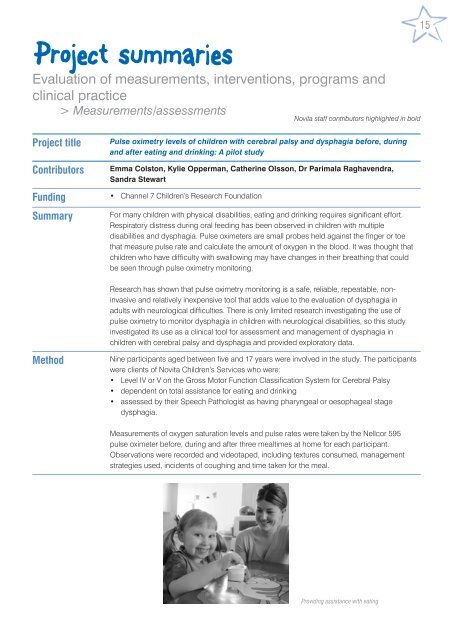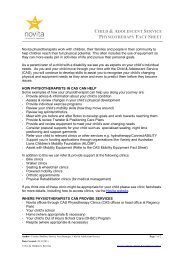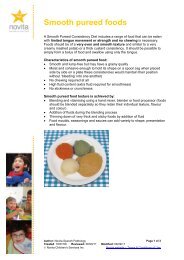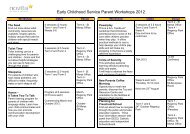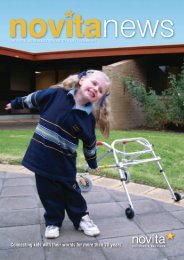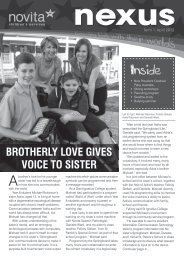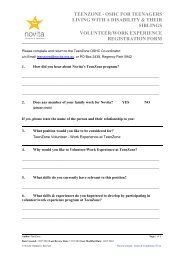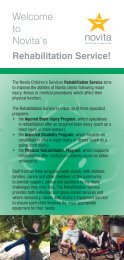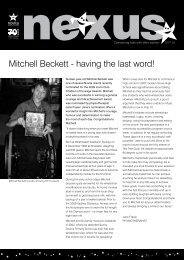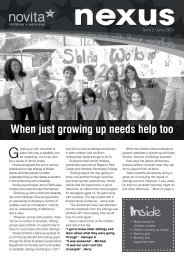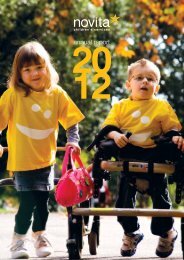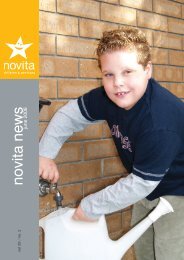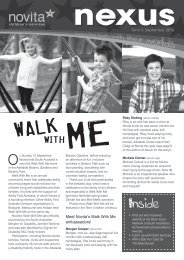Novita Research Report - 2004 to 2007 - Novita Children's Services
Novita Research Report - 2004 to 2007 - Novita Children's Services
Novita Research Report - 2004 to 2007 - Novita Children's Services
- No tags were found...
You also want an ePaper? Increase the reach of your titles
YUMPU automatically turns print PDFs into web optimized ePapers that Google loves.
Project summaries15Evaluation of measurements, interventions, programs andclinical practice> Measurements/assessments<strong>Novita</strong> staff contribu<strong>to</strong>rs highlighted in boldProject titleContribu<strong>to</strong>rsFundingSummaryPulse oximetry levels of children with cerebral palsy and dysphagia before, duringand after eating and drinking: A pilot studyEmma Cols<strong>to</strong>n, Kylie Opperman, Catherine Olsson, Dr Parimala Raghavendra,Sandra Stewart• Channel 7 Children’s <strong>Research</strong> FoundationFor many children with physical disabilities, eating and drinking requires significant effort.Respira<strong>to</strong>ry distress during oral feeding has been observed in children with multipledisabilities and dysphagia. Pulse oximeters are small probes held against the finger or <strong>to</strong>ethat measure pulse rate and calculate the amount of oxygen in the blood. It was thought thatchildren who have difficulty with swallowing may have changes in their breathing that couldbe seen through pulse oximetry moni<strong>to</strong>ring.<strong>Research</strong> has shown that pulse oximetry moni<strong>to</strong>ring is a safe, reliable, repeatable, noninvasiveand relatively inexpensive <strong>to</strong>ol that adds value <strong>to</strong> the evaluation of dysphagia inadults with neurological difficulties. There is only limited research investigating the use ofpulse oximetry <strong>to</strong> moni<strong>to</strong>r dysphagia in children with neurological disabilities, so this studyinvestigated its use as a clinical <strong>to</strong>ol for assessment and management of dysphagia inchildren with cerebral palsy and dysphagia and provided explora<strong>to</strong>ry data.MethodNine participants aged between five and 17 years were involved in the study. The participantswere clients of <strong>Novita</strong> Children’s <strong>Services</strong> who were:• Level IV or V on the Gross Mo<strong>to</strong>r Function Classification System for Cerebral Palsy• dependent on <strong>to</strong>tal assistance for eating and drinking• assessed by their Speech Pathologist as having pharyngeal or oesophageal stagedysphagia.Measurements of oxygen saturation levels and pulse rates were taken by the Nellcor 595pulse oximeter before, during and after three mealtimes at home for each participant.Observations were recorded and videotaped, including textures consumed, managementstrategies used, incidents of coughing and time taken for the meal.Providing assistance with eating


